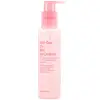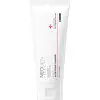What's inside
What's inside
 Key Ingredients
Key Ingredients

 Benefits
Benefits

 Concerns
Concerns

 Ingredients Side-by-side
Ingredients Side-by-side

Water
Skin ConditioningSodium Lauroyl Sarcosinate
CleansingCocamidopropyl Betaine
CleansingLauramide DEA
Diglycerin
HumectantPEG-120 Methyl Glucose Dioleate
EmulsifyingSodium Chloride
MaskingDisodium Cocoamphodiacetate
CleansingSodium Lauroyl Glutamate
Gluconolactone
Skin ConditioningCapryloyl Salicylic Acid
ExfoliatingButylene Glycol
HumectantHexylene Glycol
EmulsifyingPanthenol
Skin ConditioningMaltodextrin
AbsorbentCitric Acid
BufferingBeta-Glucan
Skin ConditioningSalix Alba Bark Extract
AstringentRosmarinus Officinalis Extract
AntimicrobialLavandula Angustifolia Extract
Skin ConditioningThymus Vulgaris Extract
PerfumingRosa Canina Fruit Extract
AstringentMentha Piperita Extract
CleansingJasminum Officinale Extract
MaskingHibiscus Sabdariffa Flower Extract
Skin ConditioningChamomilla Recutita Extract
Skin ConditioningCalendula Officinalis Extract
Skin ConditioningAspalathus Linearis Extract
Skin ConditioningCyanocobalamin
Skin ConditioningSodium Benzoate
MaskingChlorphenesin
Antimicrobial1,2-Hexanediol
Skin ConditioningWater, Sodium Lauroyl Sarcosinate, Cocamidopropyl Betaine, Lauramide DEA, Diglycerin, PEG-120 Methyl Glucose Dioleate, Sodium Chloride, Disodium Cocoamphodiacetate, Sodium Lauroyl Glutamate, Gluconolactone, Capryloyl Salicylic Acid, Butylene Glycol, Hexylene Glycol, Panthenol, Maltodextrin, Citric Acid, Beta-Glucan, Salix Alba Bark Extract, Rosmarinus Officinalis Extract, Lavandula Angustifolia Extract, Thymus Vulgaris Extract, Rosa Canina Fruit Extract, Mentha Piperita Extract, Jasminum Officinale Extract, Hibiscus Sabdariffa Flower Extract, Chamomilla Recutita Extract, Calendula Officinalis Extract, Aspalathus Linearis Extract, Cyanocobalamin, Sodium Benzoate, Chlorphenesin, 1,2-Hexanediol
Water
Skin ConditioningLauryl Hydroxysultaine
CleansingSodium Chloride
MaskingPotassium Cocoyl Glycinate
Acrylates Copolymer
Disodium Cocoamphodiacetate
CleansingSodium Methyl Cocoyl Taurate
CleansingPotassium Cocoate
EmulsifyingSalicylic Acid
MaskingSodium Benzoate
MaskingMelaleuca Alternifolia Leaf Oil
AntioxidantHexylene Glycol
EmulsifyingDisodium EDTA
Citric Acid
BufferingGuaiazulene
AntimicrobialGluconolactone
Skin ConditioningCalamine
AbsorbentPanthenol
Skin ConditioningCapryloyl Salicylic Acid
ExfoliatingGlycyrrhiza Glabra Root Extract
BleachingGlycolic Acid
BufferingButylene Glycol
Humectant1,2-Hexanediol
Skin ConditioningCamellia Sinensis Leaf Extract
AntimicrobialCentella Asiatica Extract
CleansingMadecassoside
AntioxidantMelaleuca Alternifolia Leaf Extract
PerfumingWater, Lauryl Hydroxysultaine, Sodium Chloride, Potassium Cocoyl Glycinate, Acrylates Copolymer, Disodium Cocoamphodiacetate, Sodium Methyl Cocoyl Taurate, Potassium Cocoate, Salicylic Acid, Sodium Benzoate, Melaleuca Alternifolia Leaf Oil, Hexylene Glycol, Disodium EDTA, Citric Acid, Guaiazulene, Gluconolactone, Calamine, Panthenol, Capryloyl Salicylic Acid, Glycyrrhiza Glabra Root Extract, Glycolic Acid, Butylene Glycol, 1,2-Hexanediol, Camellia Sinensis Leaf Extract, Centella Asiatica Extract, Madecassoside, Melaleuca Alternifolia Leaf Extract
 Reviews
Reviews

Ingredients Explained
These ingredients are found in both products.
Ingredients higher up in an ingredient list are typically present in a larger amount.
1,2-Hexanediol is a synthetic liquid and another multi-functional powerhouse.
It is a:
- Humectant, drawing moisture into the skin
- Emollient, helping to soften skin
- Solvent, dispersing and stabilizing formulas
- Preservative booster, enhancing the antimicrobial activity of other preservatives
Butylene Glycol (or BG) is used within cosmetic products for a few different reasons:
Overall, Butylene Glycol is a safe and well-rounded ingredient that works well with other ingredients.
Though this ingredient works well with most skin types, some people with sensitive skin may experience a reaction such as allergic rashes, closed comedones, or itchiness.
Learn more about Butylene GlycolCapryloyl Salicylic Acid comes from salicylic acid, the famous acne-fighting BHA.
It usually goes by a more common name of LHA, or lipohydroxy acid.
Like salicylic acid, this ingredient is a chemical exfoliant that can help break down the oil in your pores and reduce inflammation.
Though studies for LHA do show it to be less effective than salicylic acid. To be fair, salicylic acid is the reigning monarch of acne treatments.
However, a study from 2009 found LHA to be comparable to BPO, making it a good alternative for people with sensitive skin. Another study of 14 patients found a significant decrease in comedones after using LHA.
Another pro of LHA? It is less irritating than salicylic acid due to its large molecule size.
Large molecules cannot penetrate skin as well, so they are gentler on the skin. LHA is much less penetrative than salicylic acid.
An in-vitro study (not done on a living organism) found only 6% of LHA penetrated past the statum corneum compared to 58% of salicylic acid. An in-vivo (done on a living organism) analysis revealed ~17% of LHA was still present in the top layer of skin after 4 days, versus ~9% of salicylic acid.
Interestingly, a study from 2008 found LHA comparable to another famous acid, glycolic acid.
This study found about 10% of LHA is as effective as 20-50% of glycolic acid in treating hyperpigmentation and fine-lines.
Hydroxy acids have been found to stimulate skin protein, lipids, and thermal thickening. This may have anti-aging benefits.
Learn more about Capryloyl Salicylic AcidCitric Acid is an alpha hydroxy acid (AHA) naturally found in citrus fruits like oranges, lemons, and limes.
Like other AHAs, citric acid can exfoliate skin by breaking down the bonds that hold dead skin cells together. This helps reveal smoother and brighter skin underneath.
However, this exfoliating effect only happens at high concentrations (20%) which can be hard to find in cosmetic products.
Due to this, citric acid is usually included in small amounts as a pH adjuster. This helps keep products slightly more acidic and compatible with skin's natural pH.
In skincare formulas, citric acid can:
While it can provide some skin benefits, research shows lactic acid and glycolic acid are generally more effective and less irritating exfoliants.
Most citric acid used in skincare today is made by fermenting sugars (usually from molasses). This synthetic version is identical to the natural citrus form but easier to stabilize and use in formulations.
Read more about some other popular AHA's here:
Learn more about Citric AcidDisodium Cocoamphodiacetate is a surfactant and helps cleanse skin. It is created from the fatty acids of coconut oil.
Surfactants help rinse oil, dirt, and other pollutants easily from skin. It has a faint fruit-like scent.
Gluconolactone is a PHA. PHAs are a great gentle alternative to traditional AHAs.
When applied, Gluconolactone has the same affect on skin as AHAs such as lactic acid. It helps dissolve the dead skin cells in the top layer of your skin. This improves texture and brightens the skin.
PHAs are more gentle than AHAs due to their larger structure. They do not penetrate as deeply as AHAs and take a longer time to dissolve dead cells. Studies show PHAs do not cause as much irritation.
Gluconolactone has some interesting properties:
In a 2004 study, Gluconolactone was found to prevent UV damage in mouse skin cells and has not been found to increase sun sensitivity. However, we still recommend wearing SPF daily.
This ingredient is is an created by reacting gluconic acid with an alcohol.
Learn more about GluconolactoneHexylene Glycol is a surfactant. Glycols are a class of alcohols. Hexylene Glycol is a surfactant and emulsifier.
As a surfactant, Hexylene Glycol helps gather dirt and oil on your skin to be washed away.
As an emulsifier, Hexylene Glycol helps keep water and oil together. This prevents them from separating in a product. Hexylene Glycol also thins out the texture of a product by lessening viscosity.
Hexylene Glycol has a small molecular weight.
Learn more about Hexylene GlycolPanthenol is a common ingredient that helps hydrate and soothe the skin. It is found naturally in our skin and hair.
There are two forms of panthenol: D and L.
D-panthenol is also known as dexpanthenol. Most cosmetics use dexpanthenol or a mixture of D and L-panthenol.
Panthenol is famous due to its ability to go deeper into the skin's layers. Using this ingredient has numerous pros (and no cons):
Like hyaluronic acid, panthenol is a humectant. Humectants are able to bind and hold large amounts of water to keep skin hydrated.
This ingredient works well for wound healing. It works by increasing tissue in the wound and helps close open wounds.
Once oxidized, panthenol converts to pantothenic acid. Panthothenic acid is found in all living cells.
This ingredient is also referred to as pro-vitamin B5.
Learn more about PanthenolSodium Benzoate is a preservative. It's used in both cosmetic and food products to inhibit the growth of mold and bacteria. It is typically produced synthetically.
Both the US FDA and EU Health Committee have approved the use of sodium benzoate. In the US, levels of 0.1% (of the total product) are allowed.
Sodium benzoate works as a preservative by inhibiting the growth of bacteria inside of cells. It prevents the cell from fermenting a type of sugar using an enzyme called phosphofructokinase.
It is the salt of benzoic acid. Foods containing sodium benzoate include soda, salad dressings, condiments, fruit juices, wines, and snack foods.
Studies for using ascorbic acid and sodium benzoate in cosmetics are lacking, especially in skincare routines with multiple steps.
We always recommend speaking with a professional, such as a dermatologist, if you have any concerns.
Learn more about Sodium BenzoateChances are, you eat sodium chloride every day. Sodium Chloride is also known as table salt.
This ingredient has many purposes in skincare: thickener, emulsifier, and exfoliator.
You'll most likely find this ingredient in cleansers where it is used to create a gel-like texture. As an emulsifier, it also prevents ingredients from separating.
There is much debate on whether this ingredient is comedogenic. The short answer - comedogenic ratings don't tell the whole story. Learn more about comegodenic ratings here.
The concensus about this ingredient causing acne seems to be divided. Research is needed to understand if this ingredient does cause acne.
Scrubs may use salt as the primary exfoliating ingredient.
Learn more about Sodium ChlorideWater. It's the most common cosmetic ingredient of all. You'll usually see it at the top of ingredient lists, meaning that it makes up the largest part of the product.
So why is it so popular? Water most often acts as a solvent - this means that it helps dissolve other ingredients into the formulation.
You'll also recognize water as that liquid we all need to stay alive. If you see this, drink a glass of water. Stay hydrated!
Learn more about Water